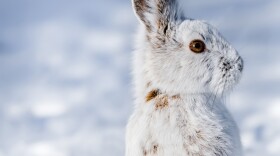In her senior years, our yellow Labrador, Oakley, loved to lounge on the ponderosa pine-shaded deck off the back of our home in Helena. Weather permitting, Oakley basked in the sunshine or curled up in the shade. We left food and water for her to enjoy while we were at work. Life was sublime until the neighborhood bullies, a bellicose assembly of Black-billed Magpies (scientific name Pica hudsonia), initiated a relentless campaign of dog food theft. Oakley was not amused. Her disposition was frayed into irritation, and the war was on.
Determined to protect her food, Oakley wrapped her body around the bowl as a barrier. The villainous looters were unfazed. They relentlessly attacked, flying, hopping, or strutting barely out of the dog's reach. The kerfuffle intensified when a single bird flew down from the trees to the edge of the deck and sashayed back and forth, raising a noisy ruckus to attract Oakley’s attention. Almost immediately, other magpies flew in from the side or the rear to snatch some food cubes before hightailing into the trees.
Somewhere from two to ten magpies participated in the dog food appropriation campaign. As long as there were two birds, the game was on. Eventually, they learned they could eat at leisure if they shoved the dish off the edge of the deck, causing it to fall into the fenced-off shrubs below. Rather than swallow the food on the spot, they tended to gobble up a surprisingly large number of cubes and fly off with them to either cache or secretly consume them.
The battle for food was inherently unfair; size and strength offered no advantage against cunning creatures whose problem-solving abilities, according to many scientific sources, are comparable to those of kindergarten-aged children. Magpies are social and vocal by habit and custom, and they work cooperatively to access a food source, even if a limited number of individuals benefited from any particular raid.
I could do little to help until a partial solution came unexpectedly. One afternoon, I sat on the front deck on the opposite side of the house, cracking and eating peanuts and flicking the shells out into the yard. Later in the day, I noticed the husks were missing. A mischief (a flock) of magpies in a nearby mountain ash tree suggested the identity of the thieves. I grabbed a handful of nuts, scattered them in the yard, and waited. The magpies went after the peanuts with gusto. From then on, as long as I supplied the magpies with peanuts, they left the dog food alone.
On the suggestion of an experienced birder, I bought a wire wreath and stuffed it with unshelled peanuts. If I kept the wreath full, the magpies spent hours skirmishing with each other to grab a peanut. I reveled in watching the mayhem. The unfolding social dynamics were hilarious. I witnessed the young of the year grudgingly learn about rank and privilege as they tried to grab a peanut before the adults had had their fill. Feathers often flew as beatings were delivered with clicking beaks, flapping wings, kicks and avian cursing and obscenities.
I continued feeding the magpies for years after Oakley was gone, even after we moved to our current home in Lolo. I did not stop feeding them until this summer when the arrival of avian flu made it risky to provide a possible source of contagion. This did not please the magpies. They frequently visit our deck, line up on the railing, and shout at me in a deafening, discordant chorus of pleas and threats, demanding my attention. There is no mistaking what they want from me—none whatsoever.
Today’s Field Note was written in the Field Notes Writing Workshop at the Montana Natural History Center. This is Rick Davenport for Field Notes, brought to you by the Montana Natural History Center, providing natural history education for schools and the public throughout Montana. To find out about upcoming events and programs at the Center, call 406.327.0405 or visit our website at MontanaNaturalist.org.





